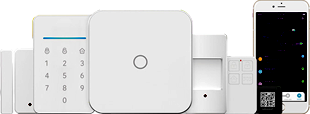Differences and Similarities between CCTV and IP Cameras
April 10, 2019
What is a CCTV Surveillance System?
A CCTV, or closed-circuit television, surveillance system transmits the feed of its connected security cameras to a specific location. The network of security cameras makes up a complete system and the signals are not publicly distributed to outside receivers. A CCTV system functions with strategically-placed security cameras and human monitoring of the cameras’ video feeds on an internal system of monitors. Video feeds may also be recorded on a separate digital video recorder or DVR. If the DVR is connected to the internet, remote viewing of video footage may also be available. CCTV is an older system that has developed and modernized, adding new features throughout the years.
CCTV cameras are most often used in business or government settings, or for monitoring large areas such as retail stores, banks, and other institutions. They are often seen surveilling various public areas in cities, such as parks and highways. Law enforcement professionals often use them to monitor public behaviour, traffic patterns, and more, to help secure public safety.
What are IP Cameras?
IP, or internet protocol, cameras are digital video cameras that transmit video footage via a computer network. IP cameras typically feature better picture quality, advanced recording features, and the capability of connecting a larger number of cameras to the system, when compared with the older CCTV systems. Videos are stored digitally using a network video recorder, or NVR, rather than a physical DVR. Additionally, IP cameras are easy to install and have flexible expansion capabilities in terms of connecting additional cameras, other systems, and storage applications. IP cameras can be used in conjunction with CCTV systems to cover blind spots or have cameras where they are less likely to be seen and discovered.
IP cameras can be used in a variety of settings, from business to personal. Because many IP cameras are wireless, placement can be much more flexible, offering you versatility in your security. IP cameras offer remote viewing options, making them perfect for situations where you want to monitor what’s happening even when you’re away
A Comparison of CCTV and IP Cameras
There are some major differences between CCTV systems and IP cameras. Although IP cameras are the modern choice, many business owners and property managers prefer to use CCTV cameras to monitor large spaces. Below is a comparison of some of the main features of each system
CCTV Cameras
Sends video back to a base station or DVR (digital video recorder) via coax or UTP cabling
The video is recorded on a physical DVR which can be connected to the internet for remote viewing capabilities
Power and network cables run between each camera and the base station
Because cabling is required, CCTV cameras all have to be in one location
Cameras typically offer lower resolution of 960 x 480, but some systems offer HD resolution
Primarily provides video surveillance without advanced features
There is a physical limit to the number of cameras that can be added to the network, usually fewer than 12
2-way audio for communication with people on the other end
Uses television broadcast signals
IP Cameras
Broadcasts video as a digital stream over an IP network to an NVR (network video recorder) where videos are stored digitally rather than physically
Often have SD cards, allowing them to record locally, or sends video via the internet to an NVR
Uses PoE (Power over Ethernet) making it unnecessary to run power cables
Because cabling is not always required, IP cameras do not all need to be kept in one location
Some cameras feature an increased resolution of 4096 x 2160. Standard resolution tends to be 1080p HD.
Includes advanced features such as analytics, advanced motion detection, and remote focus
Can add nearly unlimited cameras to the network
2-way audio for communication with people on the other end
Uses WiFi and bandwidth
To buy click here










 Cart (9)
Cart (9)